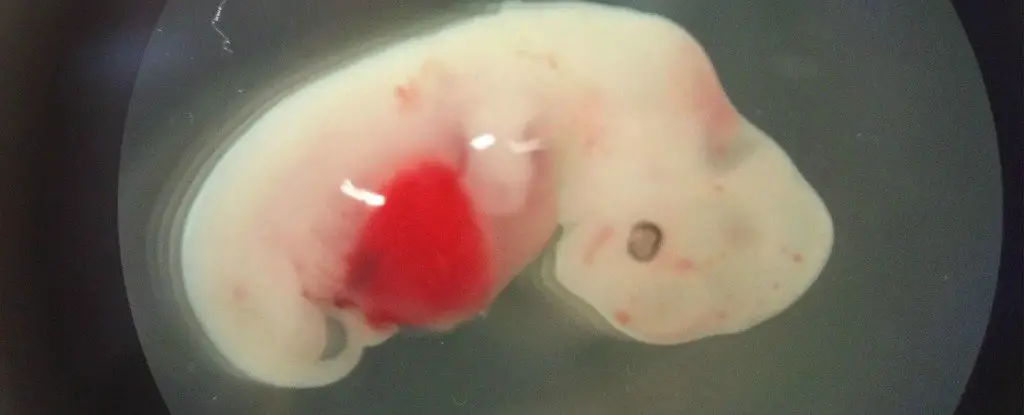Scientists Inject Human Cells Into Pig Embryo To Create First Human-Pig Hybrid
Tags: opinion

By Amanda Froelich Truth Theory
In a move that can only be deemed controversial, the first pig-human hybrid has been created in a lab. Researchers successfully grew human cells inside early-stage pig embryos, leading to the creation of the first pig-human hybrids. The result is described as an interspecies chimeras.
The experiment is still in its early days, but scientists believe the “breakthrough” could one day lead to lab-grown human organs that could be transplanted into people who need them. If successful, hundreds of thousands of lives would be saved.
Science Alert reports that for the experiment, US researchers injected human stem cells into early-stage pig embryos. The hybrid embryos were then transferred into surrogate sows. The researchers waited until the embryos developed into the first trimester.
All in all, more than 150 of the embryos developed into chimeras. Each had developed the precursors of organs, including the heart and liver. They also contained a small amount of human cells — approximately 1 in 10,000 of the hybrid cells were human.
Said team member Juan Carlos Izpisua Belmonte, from the Salk Institute in California: “Our findings may offer hope for advancing science and medicine by providing an unprecedented ability to study early embryo development and organ formation, as well as a potential new avenue for medical therapies.”
He added, “We have shown that a precisely targeted technology can allow an organism from one species to produce a specific organ composed of cells from another species.”
Though reactions to the development have been mixed, it cannot be ignored that science has leapt forward now that the first human-pig hybrid has been created. Now, the ethical implications need to be worked out.
In 2015, Izpisua Belmonte and his colleagues performed experiments to create interspecies chimeras in the lab. The team successfully integrated human stem cells into mouse embryos, showing that human stem cells can develop inside other species. They effectively created a world-first chimera.
The word chimera comes from Greek mythology. According to legend, it was a monstrous, fire-breathing hybrid creature of Lycia in Asia minor. It was composed of the parts of more than one animal. Most often, it was depicted as a lion with a goat’s head sticking from the side of its neck, and a snake for a tail. Biology describes the chimera as a natural or artificial development of one individual organisms containing cells from another. For understandable reasons, scientists are fascinated by chimeras.
As National Geographic reports, there are two ways to make a chimera. The first method is to introduce the organs of one animal into another. This is risky, as the host’s immune system may cause the organ to be rejected. The other method is to introduce one animal’s cells into the embryo of another at the embryonic level and let them grow together into a hybrid. This can be done intentionally in a lab, or can happen accidentally — such as the time a man failed his paternity test because he absorbed his twin in the womb.
Regarding the pig-human hybrid, Belmonte said, “The ultimate goal of chimeric research is to learn whether we can use stem-cell and gene-editing technologies to generate genetically-matched human tissues and organs, and we are very optimistic that continued work will lead to eventual success.” He added, “But in the process we are gaining a better understanding of species evolution as well as human embryogenesis and disease that is difficult to get in other ways.”
The hybrid embryos for the pig-human hybrid experiment were terminated after 28 days of development to avoid further ethical concerns. Debate on the ethics is expected to continue, as the National Institutes of Health (NIH) previously issued a moratorium on human chimera experimentation, but is now considering reversing the ban.
Proponents of the research argue that the experimentation is justified, because 22 people die every day in the United States waiting for an organ transplant and someone new is added to a donor list every 10 minutes.
The team’s work was published in Cell. In the video below, they discuss their results:
Image credit: Juan Carlos Izpisua Belmonte
What are your thoughts? Please comment below and share this news!
Read more: This Dying 24-Year-Old Has Life Advice You May Not Be Ready To Hear
Image Credit : Flickr
I am Luke Miller, content manager at Truth Theory and creator of Potential For Change. I like to blend psychology and spirituality to help you create more happiness in your life.Grab a copy of my free 33 Page Illustrated eBook- Psychology Meets Spirituality- Secrets To A Supercharged Life You Control Here

Leave Comment: